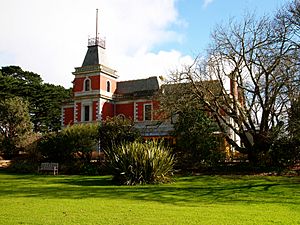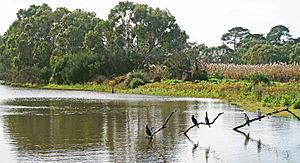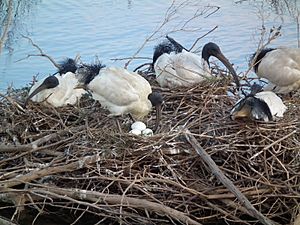Coolart Wetlands and Homestead Reserve facts for kids

Coolart homestead in winter
|
The Coolart Wetlands and Homestead Reserve, often called just Coolart, is a special place in Victoria, Australia. It's about 70 kilometers (43 miles) south-east of Melbourne. This large estate covers 87.5 hectares (about 216 acres) on the coast of Western Port. It has a beautiful old house, called a homestead, built in the late 1800s. Coolart is one of the oldest farming properties on the Mornington Peninsula.
Today, Coolart is a mix of gardens, wetlands, and coastal woodlands. You can find many walking tracks here. Parks Victoria manages the property, and the homestead is open for visitors. Inside the homestead, you can see old photographs and changing art shows. Coolart is a great spot for picnics, nature walks, and birdwatching.
Contents
What You Can See at Coolart
Coolart is surrounded by Merricks Creek to the south and farmland to the north. It includes the main Coolart Homestead, which is a big two-story brick house with a tower. There are also other smaller buildings.
Gardens and Wetlands
The property has a well-kept garden and several wetland areas. These wetlands are important homes for many birds. You can use a special bird hide to watch birds without disturbing them. There is also a wetland observatory with educational displays.
Wildlife at Coolart
The wetlands are home to a large group of over 1000 Australian white ibises. These birds build their nests and raise their young here. In the woodlands, you might spot koalas, swamp wallabies, and echidnas. It's a wonderful place to see Australian wildlife up close.
The History of Coolart
Coolart was originally the land of the Bunurong people. The name "coolart" comes from their word "colourt" or "kulluk," which was the name for nearby Sandy Point.
Early European Settlement
In 1839, European settlers, the Meyrick brothers, took over Coolart as a pastoral lease for farming. Over the years, the property was used for different types of farming, including growing crops and raising sheep and cattle.
The Grimwade Family and the Homestead
In 1895, a businessman and politician from Melbourne named Frederick Sheppard Grimwade bought Coolart. He built the large homestead right after, as a country getaway for his family.
Tom Luxton's Vision
After passing through a few owners, Tom Luxton bought Coolart in 1937. He loved wildlife and convinced the government to make Coolart a wildlife sanctuary. Luxton started building artificial lakes and other wetlands to create better homes for waterbirds.
Coolart Today
When Tom Luxton passed away in 1968, the Victorian State Government bought Coolart. They wanted to protect the land and use it for education. Since 1996, Parks Victoria has managed the property. Coolart's land and buildings are now listed on the Victorian Heritage Register, which means they are important historical sites.
A special plaque at Coolart remembers Graham Pizzey. He was a famous Australian author, photographer, and ornithologist (someone who studies birds). He was the first "Warden" of Coolart from 1980 to 1984.




